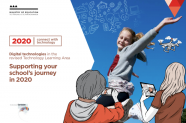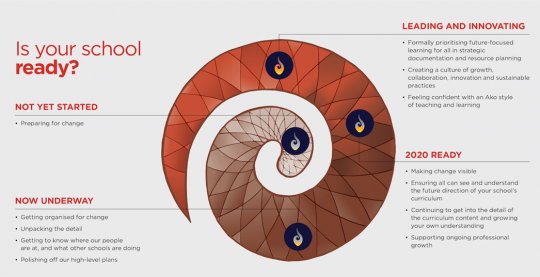Digital technologies implementation support tool
This tool gives a process and plan to support schools with teaching the revised technology learning area. It was made for school leaders, school teams, clusters of schools, and boards of trustees to help with change planning.
To produce this tool, the Ministry of Education used evidence from the case studies evaluations report: "On Your Marks ... Get Set ... Go! A Tale of Six Schools and the Digital Technologies Curriculum Content", Education Review Office, 23 January 2020.
Download the PDF documents
Download the complete document:

Digital technologies implementation support tool 2020 (PDF, 5 MB)
Download the individual PDFs for each level:
Not yet started DT implementation support 2020 (PDF, 1 MB)
Now underway DT implementation support 2020 (PDF, 1 MB)
2020 ready DT implementation support (PDF, 1 MB)
Leading and innovating DT implementation support 2020 (PDF, 1 MB)
What, why, and how
What do you need to know before using this tool?
In 2017, the national curriculum was revised to explicitly include digital technologies learning. This tool has been made to support those using The New Zealand Curriculum as their national curriculum framework (see alert #1 below).
School leaders have the opportunity to make the revised technology learning area cross-curricular, as part of their local curriculum. It is not something that is expected to be taught in isolation but rather integrated into an authentic learning . Look for opportunities to weave this new curriculum content through teaching and learning that’s happening already.
Alert #1
The New Zealand Curriculum is a framework that sets out national requirements and expectations of learning.
Local curriculum is where the national expectations of learning are then shaped so that it has local and meaning to learners.
School leadership works out how to shape and design their local curriculum by collaborating with parents, whānau, hapū, iwi, and the wider community.
Teachers create teaching and learning programmes that fit their local curriculum direction.
For more information on the revised technology learning area see:
Why was there a curriculum change to the technology learning area?
This is about preparing children and young people of New Zealand to thrive in a transforming digital world. Ensuring all of our young people develop the knowledge, skills and capabilities to deal with new problems and opportunities as they arise and be safe while doing so. This is to support the next generation of influencers, creators and thinkers to design digital technologies solutions – and make the world a better place.
We want to ensure that all of our tamariki and young people have the learning opportunities to gain the new specific technological skills and capabilities required for the future of work – an estimated 85% of jobs that will exist in 2030 haven’t been invented yet*. But more than this, we want to support children and young people to develop a strong sense of digital citizenship as people relate to one another in a way unlike before. This is why we need to focus digital technologies learning around the wellbeing of ourselves and others.
* Dell Technologies and IFTF. 2017. The Next Era of Human/Machine Partnerships: Emerging technologies’ impact on society & work in 2030. Institute for the Future (IFTF).
How will this curriculum change progress?
We are on this journey together to improve outcomes for all learners of Aotearoa.
Change takes time, and each school will be starting from a different stage on their journey to confidently and capably teach the revised technology learning area.
No school needs to feel like they are on their own.
We encourage schools to collaborate. Different schools will have different approaches to this change – whether your school is large or small, or you work as part of a network – it is about what works for you and your learners.
Together, we are committed to this mahi to make sure that all tamariki and young people of Aotearoa are positioned to capably take part in our evolving digital society and thrive in the future. This journey will continue to evolve from this point.
Implementation model process
There are four levels in the process.
Digital technologies implementation process diagram
Four levels
Read the summary of characteristics and select the level to go to the detailed action steps.
- Preparing for change.
- Getting organised for change.
- Unpacking the detail.
- Getting to know where our people are at, and what other schools are doing.
- Polishing off our high-level plans.
- Making change planning visible.
- Ensuring all can see and understand the future direction of your school's curriculum.
- Continuing to get into the detail of the curriculum content and growing your own understanding.
- Supporting ongoing professional growth.
- Formally prioritising future-focused learning for all in strategic documentation and resource planning.
- Creating a culture of growth, collaboration, innovation, and sustainable practices.
- Feeling confident with an Ako style of teaching and learning.

